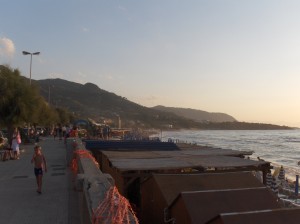Home » Blog posts » Observation of Lungomare
Observation of Lungomare
Posted by Arthi on Thursday, June 2, 2016 in Blog posts.
 I spent an afternoon sitting on a bench on Lungomare, facing the ocean, people-watching, and eating gelato. Around me were couples, families, or random passerby walking, and vendors hawking their souvenir items. I could hear the roar of the waves from the beach and random snatches of Italian floating by on the sea breeze. It was a peaceful scene.
I spent an afternoon sitting on a bench on Lungomare, facing the ocean, people-watching, and eating gelato. Around me were couples, families, or random passerby walking, and vendors hawking their souvenir items. I could hear the roar of the waves from the beach and random snatches of Italian floating by on the sea breeze. It was a peaceful scene.
I watched the interaction of one of the vendors with the people passing. He looked to be in his late 40s-early 50s, and was wearing a thin blue button-down shirt, kakhi pants, and sandals. He had a chair in the shade, and in front of him was a wide table covered in hats, beach towels, and train pieces shaped like letters. He had one of the largest collections of goods on Lungomare, and seemed to be older than the other vendors. He had a younger man hanging around him, maybe his son. While the other vendors were actively calling out to the people, trying to engage them, this gentleman was leaning back in his chair, relaxed and quiet, letting his large table and variety do the talking.
Another interesting thing I noticed during my observations was the dramatic increase in number of people on the street after 3:30pm. I had seen a similar increase in energy while in Castelbuono: I was sitting in a piazza enjoying my latte and gelato (again) when my attention was caught by the trinket shop to my left. I scrutinized the shop display, searching for cute souvenirs I could bring home for my family and friends. Yet I couldn’t actually browse because the shop, like the majority of businesses along the street, were closed for their owners’ daily siestas. In both Lungomare and Castelbuono, the drop in activity around 1pm, and subsequent increase after around 3-4pm, were so drastic that the phenomenon merited stopping to observe and take note. The concept of siestas is incredibly European, and very opposite of the American lifestyle. In my recent responses and blog posts, I’ve been churning over a theme I’ve noticed through Sicily where young ambitious people end up leaving during their prime years, and return when older to retire — this has led to a Sicilian culture of non-ambitious but content people who take life slowly, rather than by the reigns. I can’t help but feel the concept of siestas fits perfectly within this culture.
Follow up questions I have are:
1. Where is the concept of siestas normal? Shop owners who own their own business can make their own hours, but what about people who work together or for others?
2. Is this only in small beach towns like Cefalu? Siracusa also had similar hours, but I didn’t see this in Palermo, etc.
©2024 Vanderbilt University ·
Site Development: University Web Communications